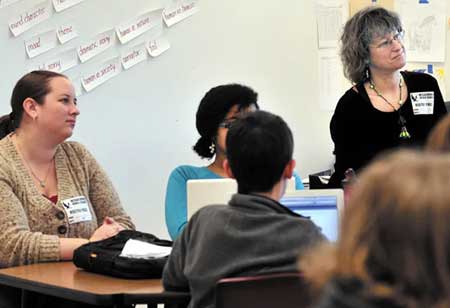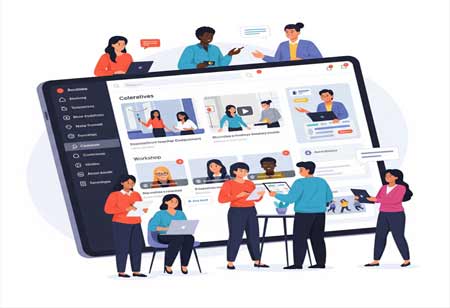THANK YOU FOR SUBSCRIBING
Be first to read the latest tech news, Industry Leader's Insights, and CIO interviews of medium and large enterprises exclusively from Education Technology Insights
Next-Gen Thinking in District Tech Leadership
District tech leaders play a crucial role in integrating technology into education, focusing on personalized learning, data analysis, and strategic planning to create future-ready learning environments.

By
Education Technology Insights | Thursday, October 23, 2025
Stay ahead of the industry with exclusive feature stories on the top companies, expert insights and the latest news delivered straight to your inbox. Subscribe today.
The educational landscape is in a state of perpetual evolution, driven significantly by the relentless march of technological innovation. At the forefront of navigating this environment are district technology leaders, individuals whose foresight and strategic acumen are crucial in identifying and integrating the next wave of educational advancements. Their role transcends mere technical support; it is about cultivating an adaptive ecosystem where technology catalyzes transformative learning experiences. This proactive approach to trendspotting is not a reactive response to emerging tools, but a deliberate and layered process of understanding pedagogical shifts, analyzing data, and envisioning future learning environments.
Decoding Pedagogical Shifts and Their Technological Implications
The bedrock of effective trendspotting for district tech leaders lies in a deep understanding of current educational philosophies and their trajectory. They closely observe pedagogical shifts, such as the increasing emphasis on personalized learning, competency-based education, and the development of future-ready skills. This involves moving beyond traditional, one-size-fits-all instruction towards models that cater to individual student needs, interests, and learning paces. Technology becomes the enabler for these shifts, facilitating adaptive learning platforms that adjust content difficulty, provide immediate feedback, and recommend tailored resources. The demand for personalized pathways necessitates intelligent systems that can assess individual mastery and suggest appropriate next steps, moving away from rigid curricula to learning journeys.
Similarly, the focus on critical thinking, collaboration, and creativity necessitates technological tools that foster these skills, moving beyond passive consumption to active engagement and creation. District tech leaders seek platforms that promote project-based learning, problem-solving, and interdisciplinary connections. They understand that fostering collaboration requires more than just shared documents; it demands interactive environments where students can co-create, communicate effectively, and learn from diverse perspectives. As such, they evaluate tools that promote virtual teamwork, offer rich multimedia creation capabilities, and enable students to present their learning in innovative ways. The shift from rote memorization to deeper conceptual understanding also drives the exploration of simulation tools and virtual labs that allow for experiential learning and hands-on exploration.
Leveraging Data and External Foresight
A significant aspect of anticipating what's next involves meticulous data analysis. District tech leaders leverage existing data to understand usage patterns, identify areas of success, and pinpoint gaps in current technological provisions. This data-driven approach extends to exploring broader educational datasets, seeking correlations between technology integration and student outcomes, engagement levels, and instructional effectiveness. By analyzing this wealth of information, they can discern emerging patterns and validate the potential impact of new tools. For instance, increased engagement with specific interactive simulations or a positive correlation between access to digital resources and improved performance in particular subjects can signal a fertile ground for further technological investment. This analytical lens allows for informed decision-making, moving beyond speculation to evidence-based planning, ensuring that new adoptions are strategically aligned with proven benefits.
Beyond internal data, district tech leaders are constantly attuned to external signals. This includes monitoring broader technology trends that might eventually permeate the education sector. They understand that innovations in areas such as AI, virtual and augmented reality, and cloud computing, although not initially designed for education, hold immense potential for reshaping learning. For example, the rapid advancements in generative artificial intelligence are closely watched for their implications on personalized tutoring, automated content creation, intelligent assessment, and even administrative efficiencies. They envision AI as a tool to augment human educators, freeing them to focus on higher-order teaching and providing individualized support to students. Similarly, the immersive experiences offered by virtual and augmented reality are viewed as potential avenues for creating engaging and experiential learning environments, from virtual field trips to simulated scientific experiments that would be otherwise impossible or impractical. The ability to identify these overarching technological currents and envision their educational applications is a hallmark of strategic foresight, requiring a blend of technical acumen and pedagogical imagination.
Strategic Planning for Future-Ready Environments
The strategic planning process then transforms these insights into actionable roadmaps. District tech leaders develop long-term technology plans that align with the district's overarching educational goals and vision. This involves prioritizing initiatives, allocating resources judiciously, and establishing clear metrics for success. They recognize that successful technology integration is not about implementing every new tool, but about selecting those that genuinely enhance teaching and learning, foster equity, and prepare students for an evolving future. This often involves piloting new technologies on a smaller scale, gathering feedback, and iteratively refining their implementation strategies before wider adoption. The emphasis is on building a robust and adaptable digital infrastructure that can support future innovations, ensuring seamless integration and scalability across all schools within the district.
Crucially, this planning involves envisioning how new technologies can create more equitable access to high-quality education. District tech leaders are mindful of the digital divide and strive to implement solutions that bridge this gap, ensuring that all students, regardless of their socioeconomic background or geographical location, have access to the same transformative learning opportunities. This may involve exploring innovative connectivity solutions, providing devices, and developing comprehensive digital literacy programs. The strategic plan also incorporates professional development for educators, recognizing that the most advanced tools are only as effective as the educators who wield them. Investment in continuous learning ensures that teachers are confident and competent in leveraging new technologies to their full potential, thereby maximizing the return on technological investments.
Ultimately, district tech leaders are the architects of future-ready learning environments. Their ability to anticipate what’s next is rooted in a comprehensive understanding of pedagogical needs, astute data analysis, a keen eye on broader technological shifts, and active engagement with the educational community. By adopting a multifaceted approach to trendspotting, districts can effectively leverage technology to create relevant educational experiences that prepare learners for a complex, tech-driven future.







